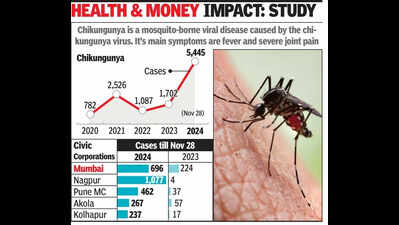Chikungunya Cases Surge in Maharashtra: 3x Increase Raises Concerns | – Times of India


Mumbai: The mosquito-borne viral disease chikungunya, which saw a threefold increase in Maharashtra’s cases this year compared to 2023, was deemed mild despite causing chronic joint pain due to its low mortality rate. However, research published on Wednesday reveals that the health and financial impact of chikungunya may have been “significantly underestimated”.
According to the peer-reviewed BMJ Global Health journal, chikungunya cost around US$ 50 billion between 2011 and 2020 and disabled millions across the world. Mumbai’s doctors, for the first time this year, reported a ‘notorious’ streak in chikungunya with patients ending up in ICUs with swelling in the brain and heart tissues. The civic health statistics showed a never-before tally of 696 cases in 2024, as against 224 cases in 2023.
Chikungunya was first reported in 1952 in Tanzania but is now a major public health concern in 110 countries, with about 18.7 million cases reported so far. About 42% (7.9 million) of these cases developed chronic disease, said the BMJ article. While 13,000 deaths were estimated in a 10-year period ending 2020, the study’s authors said the real burden of chikungunya is possibly not known due to misdiagnosis and limited diagnostic infrastructure in many countries.
Chikungunya has mild immediate symptoms — fever, intense joint pain, and rash. The study’s authors looked at the “cost” of the long-term chronic effects such as persistent arthritic-like joint pain, fatigue, and depression to arrive at the financial cost of chikungunya. They estimated that the financial toll of chikungunya between 2011-2020 was US$ 49.9 billion, comprising US$ 25.1 billion for chronic disease and US$ 24.8 billion for acute illness. Total direct costs came to US$ 2.8 billion (6% of total), and total indirect costs came to US$ 47.1 billion (94%); absenteeism was main driver of both types of cost. “Global average cost of each case was US$ 2700,” said the paper.
In Maharashtra, chikungunya’s caseload increased from 1,702 in 2023 to 5,445 in 2024, with Nagpur city (1,077) accounting for almost a fifth of cases this year. The state govt started genomic surveillance to check for a new mutation, but experts felt this year’s rain patterns – heavy rain punctuated by breaks – favoured breeding of mosquitoes that led to outbreaks in most districts. The BMJ Global Health paper said the spread has been driven by globalisation, urbanisation, and environmental changes.
Dr Gautam Bhansali from Bombay Hospital, New Marine Lines, said the worrisome infectious diseases in Mumbai were usually dengue, malaria, and leptospirosis. “However, for the first time this year, we saw a huge number of chikungunya cases not only in our clinics but also as hospital inpatients. Many had persistent high fever and joint pain that made it difficult for them to move,” he said.















